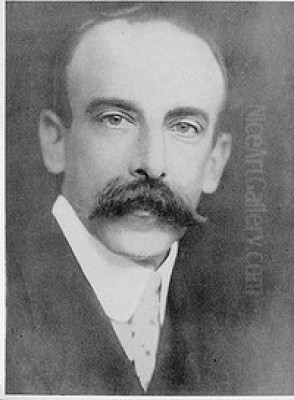
Emanuel Phillips Fox stands as a pivotal figure in the narrative of Australian art, particularly celebrated for his role in introducing and adapting European Impressionism to the unique light and landscape of his homeland. Born in Melbourne on March 12, 1865, Fox's career bridged continents, absorbing the avant-garde techniques of late 19th-century Paris and translating them into a distinctly Australian idiom. His work, characterized by luminous colour, a sensitive rendering of light, and intimate portrayals of domestic and outdoor life, earned him recognition both in Australia and internationally, leaving an indelible mark on the generations of artists who followed.
Early Life and Artistic Awakening in Melbourne
Emanuel Phillips Fox was born into a bustling family in Fitzroy, Melbourne, the seventh child of photographer Alexander Fox and Rosetta Phillips, both of Jewish heritage. His early aptitude for art was evident, leading him to enroll at the National Gallery of Victoria Art School at the young age of fifteen, around 1880. This institution, under the directorship of George Folingsby, provided a solid academic grounding based on European traditions, emphasizing drawing from the cast and life, and compositional principles.
During his time at the Gallery School, Fox studied alongside other aspiring artists who would also become significant names in Australian art, including Frederick McCubbin and Aby Altson. He proved to be a talented student, distinguishing himself in student exhibitions. Notably, he was awarded prizes for his landscape paintings in both 1884 and 1886, signalling an early interest in capturing the nuances of the natural world, a theme that would dominate much of his later work. The training received here laid the foundation for his technical proficiency, even as he would later embrace more modern, light-filled approaches.
Parisian Immersion: Training and Transformation
Seeking to further his artistic education at the epicentre of the art world, Fox travelled to Paris in 1887. This move was crucial for his development, exposing him to a whirlwind of artistic movements and influential teachers. He enrolled at the prestigious Académie Julian, a popular choice for foreign students, and later gained admission to the even more esteemed École des Beaux-Arts, the official bastion of French academic art.

In Paris, Fox studied under renowned academic painters, most significantly Jean-Léon Gérôme, known for his meticulous historical and Orientalist scenes. He also received instruction from William-Adolphe Bouguereau, another pillar of the academic establishment celebrated for his idealized nudes and mythological subjects. This rigorous training honed his draughtsmanship and compositional skills, instilling a respect for structure and form that would underpin even his most Impressionistic works.
However, Paris in the late 1880s was also the heartland of Impressionism and Post-Impressionism. Fox inevitably absorbed the revolutionary ideas circulating in the city's studios and cafes. He encountered the works of Claude Monet, Camille Pissarro, and James McNeill Whistler, artists who prioritized capturing fleeting moments, the effects of light and atmosphere, and the vibrancy of modern life using broken brushwork and a brighter palette. He also spent time painting outdoors in artists' colonies like Étaples, immersing himself in the practice of plein air painting favoured by the Impressionists and the earlier Barbizon School painters like Jean-Baptiste-Camille Corot.
This period was transformative. Fox began to synthesize the discipline of his academic training with the newfound freedom and luminosity of Impressionism. He learned to see and depict light not merely as illumination, but as a tangible element that dissolved forms and created mood. His palette brightened, and his brushwork became looser and more expressive, reflecting his engagement with these contemporary European trends. His time in France was not just about formal study; it was an immersion in a dynamic artistic environment that reshaped his vision.
Return to Melbourne: Championing the New Light
Fox returned to Melbourne in 1892, bringing with him the fresh perspectives and techniques he had acquired in Europe. Australia, particularly Melbourne, was already experiencing its own Impressionist movement, often referred to as the Heidelberg School, with artists like Arthur Streeton, Tom Roberts, and Charles Conder painting sun-drenched landscapes en plein air. Fox's return added a new dimension to this local development, infused with his direct experience of French Impressionism.
In 1893, Fox, alongside fellow artist Tudor St George Tucker, who had also studied in France, established the Melbourne School of Art. This was a significant move, creating an alternative to the more conservative National Gallery School. Their school actively promoted the modern French methods they had learned, particularly emphasizing plein air painting and the importance of capturing transient light effects. They encouraged students to work directly from nature, fostering a more immediate and vibrant approach to landscape and figure painting.
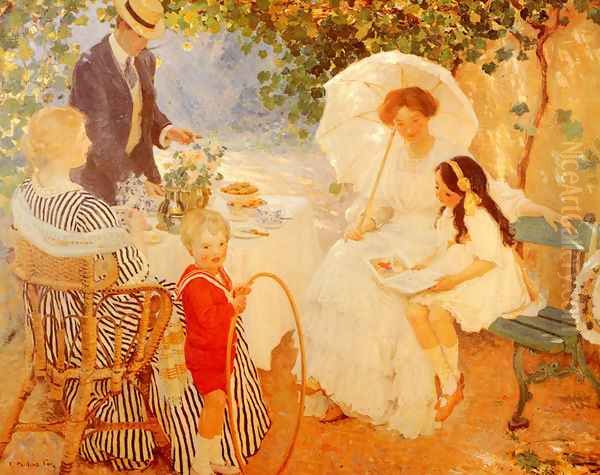
Through his teaching, Fox played a crucial role in disseminating European modernist ideas within the Australian art community. He influenced a new generation of artists, encouraging them to experiment with colour and light. His own work from this period reflects his commitment to these principles, often depicting scenes of Melbourne life and the surrounding countryside with a characteristic sensitivity to atmosphere and illumination. A key work from this time, Art Students (1895), portrays young women diligently copying classical sculptures, yet the treatment of light filtering into the studio hints at his Impressionist leanings.
Marriage and Artistic Partnership: Ethel Carrick Fox
A significant development in Fox's personal and professional life occurred during a return visit to Europe. In 1905, in London, he married the talented English-born artist Ethel Carrick. She had studied at the Slade School of Fine Art under Henry Tonks and Frederick Brown, and shared Fox's passion for modern painting, particularly Impressionism and Post-Impressionism. Their marriage marked the beginning of a close personal and artistic partnership that lasted until Fox's death.
Ethel Carrick Fox was a formidable artist in her own right, known for her vibrant, colourful depictions of bustling markets, beaches, and urban scenes, often painted with bold, expressive brushwork. The couple travelled extensively together, painting side-by-side in locations across Europe, North Africa, and Australia. They shared studios and exhibited together, and their work often displays a mutual influence, particularly in their shared fascination with capturing light, movement, and the energy of everyday life.
Their travels provided rich subject matter. They painted in Venice in 1907, capturing the unique light and atmosphere of the city. They spent time in Paris, where Ethel, in particular, excelled at depicting crowded street scenes and flower markets with a Post-Impressionist intensity of colour. Their collaboration was one of shared exploration, pushing each other's artistic boundaries while maintaining their individual styles. Ethel's work often displayed a bolder, more Fauvist use of colour compared to Emanuel's more tonal Impressionism, yet their shared commitment to modernism is evident.
Mature Style: Capturing Light, Colour, and Intimacy
Emanuel Phillips Fox's mature style is best understood as a sophisticated blend of his academic foundations and his deep engagement with French Impressionism. He became a master at rendering the subtle interplay of light and shadow, particularly the effects of dappled sunlight filtering through leaves or illuminating interiors. Unlike some of the Heidelberg School painters, whose focus was often on the bright, harsh glare of the Australian sun, Fox was frequently drawn to more nuanced conditions – the gentle light of morning or late afternoon, the soft glow of indoor scenes, or the dappled patterns found sous bois (under trees).
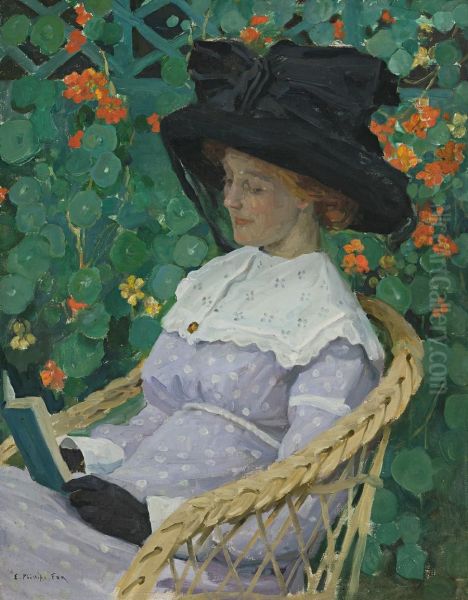
His palette was characteristically high-keyed and luminous, employing pure colours and broken brushwork to convey the sensation of light. However, his Impressionism was often tempered by a strong sense of underlying structure and form, a legacy of his academic training. His figures retain a sense of solidity, and his compositions are carefully considered, even when depicting seemingly casual moments. This balance gives his work a unique quality – both immediate and enduring, spontaneous yet composed.
Fox excelled in a variety of genres. His landscapes, whether painted in the Australian bush, the French countryside, or the gardens of Paris, consistently demonstrate his sensitivity to atmosphere and place. Works like Spring, Heidelberg (c. 1900) or Apple Trees (c. 1908) showcase his ability to capture the freshness and vibrancy of nature through colour and light. He was also a gifted painter of genre scenes, depicting moments of quiet domesticity, leisure, and social interaction with warmth and intimacy. Paintings like The Arbour (c. 1910) or Nasturtiums (c. 1912) exemplify this aspect of his work, often featuring elegantly dressed women in sunlit gardens or interiors.
Portraiture was another important facet of his oeuvre. He brought the same sensitivity to light and psychology to his portraits, capturing not just a likeness but also the sitter's personality and mood. His portraits often place the subject within a specific environment, using light and setting to enhance the characterization. His technical skill, combined with his Impressionist sensibility, made him a sought-after portraitist.
International Recognition and Major Commissions
Fox's talent did not go unnoticed on the international stage. He regularly exhibited at the prestigious Paris Salons – both the traditional Salon des Artistes Français (the "Old Salon") and the more progressive Société Nationale des Beaux-Arts (the "New Salon"). His acceptance into these competitive exhibitions was a significant achievement for an Australian artist at the time.
In 1894, he achieved a major milestone by becoming the first Australian artist to win a gold medal (third class) at the Old Salon for his painting Portrait of my Cousin. This award brought him considerable recognition in Paris. Later, in 1910, he was elected a Sociétaire (an associate member) of the New Salon, a testament to the esteem in which he was held by his French peers. This honour placed him among the leading contemporary artists exhibiting in Paris.

One of his most significant commissions came from the trustees of the National Gallery of Victoria in Melbourne. In 1901, while in London, he was commissioned to paint a large historical work depicting The Landing of Captain Cook at Botany Bay, 1770. Completed in 1902, this painting represented a departure from his usual Impressionist style, requiring a more formal, academic approach suitable for a grand historical subject. While executed with technical skill, it demonstrated his versatility but perhaps sits slightly outside the main trajectory of his more personal, light-focused work. Nonetheless, it remains an important work in the context of Australian historical painting and national identity.
Fox divided much of his later career between Europe (mainly Paris and London) and Australia, maintaining connections with both art worlds. He continued to exhibit internationally, including at the Royal Academy in London, further solidifying his reputation abroad while remaining a key figure in the Australian art scene.
Key Works Explored
Several paintings stand out as particularly representative of Emanuel Phillips Fox's artistic achievements and stylistic concerns:
Art Students (1895): Painted during his first period back in Melbourne, this work depicts female students sketching plaster casts, likely within the Melbourne School of Art he co-founded. While the subject matter relates to traditional academic training, the handling of the cool, silvery light flooding the studio and the relatively loose brushwork reveal Fox's burgeoning Impressionist sensibility. It subtly bridges the gap between the old methods and the new focus on light and atmosphere.
The Landing of Captain Cook at Botany Bay, 1770 (1902): This large-scale historical painting, commissioned by the National Gallery of Victoria, showcases Fox's academic training and ability to handle complex multi-figure compositions. While stylistically more conservative than his Impressionist works, its creation was a significant event, reflecting the nationalistic sentiments of the newly federated Australia. It demonstrates his capacity to work within established conventions when required by the subject matter.
The Arbour (c. 1910): This painting is a quintessential example of Fox's mature Impressionist style. It depicts elegantly dressed figures, likely including his wife Ethel, relaxing in a sun-dappled garden setting. The play of light filtering through the leaves is masterfully rendered using broken brushwork and a vibrant palette. The scene evokes a sense of leisurely intimacy and captures a fleeting moment of bourgeois life, a common theme in French Impressionism adapted to an Australian or European garden context.
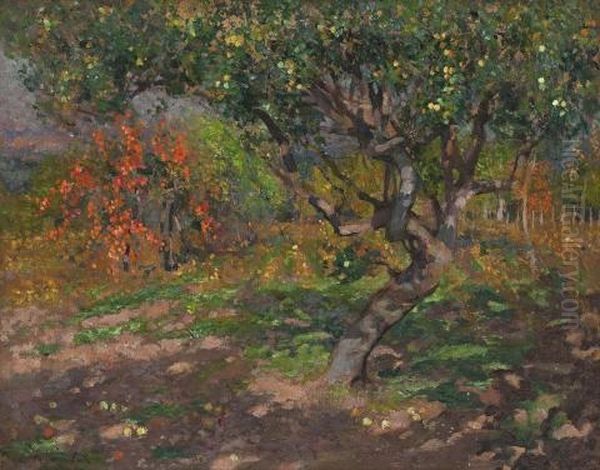
Nasturtiums (c. 1912): Often considered one of his masterpieces, this work features a female figure (possibly Ethel Carrick Fox) standing before a vibrant bank of nasturtium flowers, bathed in brilliant sunlight. The painting is a tour de force of colour and light, with the intense oranges and greens of the flowers rendered with dazzling intensity. The figure, dressed in white, acts as a reflector for the surrounding colours. It epitomizes Fox's ability to capture the sensory experience of a sunlit garden.
The Ferry (1910-11): Painted during a visit to Sydney, this work depicts passengers boarding a ferry at Circular Quay. It captures the bustle and atmosphere of urban life with a characteristically Impressionist focus on light reflecting off the water and the movement of the crowd. The composition is dynamic, and the application of paint is fluid and energetic, conveying the immediacy of the scene. It stands as one of the finest examples of Australian Impressionist urban landscape painting.
Bathing Hour (c. 1909): This charming work depicts figures, likely women and children, enjoying a moment by the sea. The focus is on the effects of bright coastal light on sand, water, and figures. The palette is bright and airy, capturing the atmosphere of a sunny day at the beach. It reflects the Impressionist interest in scenes of leisure and modern life, rendered with Fox's typical sensitivity to light and colour.
Technique, Materials, and Influences Revisited
Fox's technique was a careful calibration between control and spontaneity. His understanding of anatomy and form, derived from his academic training under masters like Gérôme, provided a solid structure for his paintings. However, his application of paint, particularly in his mature works, was clearly influenced by Impressionism. He used broken brushstrokes, placing colours side-by-side to create optical mixing and vibrancy, effectively capturing the shimmering quality of light.
He was particularly attuned to the way light affects colour, often using complementary colours in shadows or reflected light to enhance the overall luminosity of his canvases. His interest in capturing specific "effets de lumière" (effects of light) aligns him closely with the core concerns of French Impressionists like Monet and Pissarro. There are also echoes of Whistler's tonal harmonies and compositional elegance in some of his more subdued interior scenes or portraits.
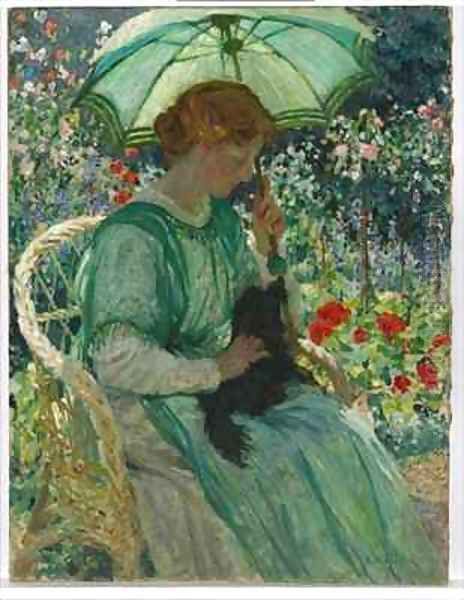
While primarily an oil painter, Fox occasionally experimented with materials. Some technical analyses of his works have suggested the use of non-traditional grounds or paint formulations, which, while perhaps contributing to certain visual effects, may have also led to conservation challenges in some instances. His admiration for earlier masters like Diego Velázquez might also be discerned in the tonal control and psychological depth found in some of his portraits, demonstrating his broad range of artistic appreciation.
Legacy and Enduring Influence
Emanuel Phillips Fox died relatively young, succumbing to cancer in Melbourne on October 8, 1915, at the age of 50. Despite his shortened career, his impact on Australian art was profound and lasting. He is widely regarded as one of Australia's foremost Impressionist painters, a key figure who helped modernize Australian art by introducing and adapting contemporary European styles.
His most significant contribution lies in his sophisticated understanding and depiction of light and colour. He brought a nuanced, European-inflected Impressionism to Australia, complementing the existing Heidelberg School tradition while offering a different sensibility – often more intimate, cosmopolitan, and focused on subtle atmospheric effects. His work demonstrated that Impressionist principles could be applied not just to the unique Australian landscape but also to genre scenes, interiors, and portraits.
As an educator, through the Melbourne School of Art, he directly influenced a generation of Australian artists, promoting plein air painting and modern French techniques. He acted as a vital link between the Australian art scene and the developments occurring in Europe, helping to broaden the horizons of Australian artists and audiences. His international success, particularly his recognition at the Paris Salons, also helped raise the profile of Australian art abroad.
Today, Emanuel Phillips Fox's paintings are held in major public collections across Australia, including the National Gallery of Australia, the National Gallery of Victoria, and the Art Gallery of New South Wales. His works are admired for their beauty, technical skill, and evocative portrayal of light and life at the turn of the 20th century. He remains a central figure in the story of Australian Impressionism, celebrated for his ability to capture fleeting moments with enduring grace and luminosity. His partnership with Ethel Carrick Fox also highlights the significant role of female artists and artistic couples in the period. His legacy endures through his luminous canvases, which continue to enchant viewers with their sensitivity and light-filled beauty.